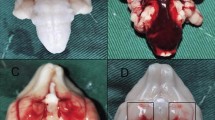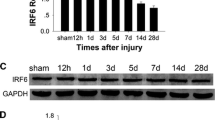Abstract
Background and object
Nuclear factor kappa B (NF-κB) functions as a key regulator in the central nervous system and regulates the inflammatory pathway. There are two peaks of cerebral NF-κB activation after neonatal hypoxia–ischemia and subarachnoid hemorrhage. Our previous studies found that NF-κB activity was up-regulated at an early stage and remained elevated at day 7 after traumatic brain injury (TBI). However, data are lacking regarding an overview of NF-κB activity and expression of NF-κB subunits after TBI. Hence, the current study was designed to detect the time course of NF-κB activation and expression of NF-κB p65 and c-Rel subunits around the contused cortex following TBI.
Methods
Adult Sprague–Dawley rats were randomly divided into sham and TBI groups at different time points. A TBI model was induced, and then the NF-κB DNA-binding activity in the surrounding areas of injured brain was detected by electrophoretic mobility shift assay. Western blotting was used to measure the protein levels of p65 and c-Rel in the nucleus. The concentrations of tumor necrosis factor-α (TNF-α) and interleukin-1β (IL-1β) were detected by enzyme-linked immunosorbent assay. Moreover, the distribution of c-Rel and p65 was examined by immunohistochemical studies.
Results
There were double peaks of cerebral cortical NF-κB activity, at 3 and 10 days post-injury. Additionally, protein levels of p65 were found to be elevated and peaked at 3 days after TBI, while levels of c-Rel were elevated significantly during the later phase of injury. Furthermore, TNF-α and IL-1β concentrations also showed a biphasic increase.
Conclusions
Biphasic activation of NF-κB could be induced after experimental TBI in rats. NF-κB p65 and c-Rel subunits were elevated at different post-TBI time periods, leading to a hypothesis that different NF-κB subunits might be involved in different pathophysiological processes after TBI.






Similar content being viewed by others
Abbreviations
- TBI:
-
Traumatic brain injury
- NF-κB:
-
Nuclear factor kappa B
- IL-1β:
-
Interleukin-1β
- TNF-α:
-
Tumor necrosis factor-α
- IκB:
-
Inhibitor of NF-κB
- ELISA:
-
Enzyme-linked immunosorbent assay
References
Lescot T, Abdennour L, Degos V, Boch AL, Puybasset L. Management of severe traumatic brain injury. Presse Med. 2007;36:1117–26.
Graham DI, McIntosh TK, Maxwell WL, Nicoll JA. Recent advances in neurotrauma. J Neuropathol Exp Neurol. 2000;59:641–51.
Greve MW, Zink BJ. Pathophysiology of traumatic brain injury. Mt Sinai J Med. 2009;76:97–104.
Lu J, Goh SJ, Tng PY, Deng YY, Ling EA, Moochhala S. Systemic inflammatory response following acute traumatic brain injury. Front Biosci. 2009;14:3795–813.
Morganti-Kossmann MC, Rancan M, Stahel PF, Kossmann T. Inflammatory response in acute traumatic brain injury: a double-edged sword. Curr Opin Crit Care. 2002;8:101–5.
Bhakar AL, Tannis LL, Zeindler C, Russo MP, Jobin C, Park DS, et al. Constitutive nuclear factor-kappa B activity is required for central neuron survival. J Neurosci. 2002;22:8466–75.
Hayden MS, Ghosh S. Signaling to NF-kappaB. Genes Dev. 2004;18:2195–224.
Mattson MP, Meffert MK. Roles for NF-kappaB in nerve cell survival, plasticity, and disease. Cell Death Differ. 2006;13:852–60.
Youssef S, Steinman L. At once harmful and beneficial: the dual properties of NF-kappaB. Nat Immunol. 2006;7:901–2.
Pizzi M, Goffi F, Boroni F, Benarese M, Perkins SE, Liou HC, et al. Opposing roles for NF-kappaB/Rel factors p65 and c-Rel in the modulation of neuron survival elicited by glutamate and interleukin-1beta. J Biol Chem. 2002;277:20717–23.
Leker RR, Shohami E. Cerebral ischemia and trauma––different etiologies yet similar mechanisms: neuroprotective opportunities. Brain Res Brain Res Rev. 2002;39:55–73.
Nijboer CH, Heijnen CJ, Groenendaal F, May MJ, van Bel F, Kavelaars A. A dual role of the NF-kappa B pathway in neonatal hypoxic-ischemic brain damage. Stroke. 2008;39:2578–86.
You WC, Li W, Zhuang Z, Tang Y, Lu HC, Ji XJ, et al. Biphasic activation of nuclear factor-kappa B in experimental models of subarachnoid hemorrhage in vivo and in vitro. Mediators Inflamm. 2012;2012:786242.
Hang CH, Shi JX, Li JS, Wu W, Yin HX. Concomitant upregulation of nuclear factor-kB activity, proinflammatory cytokines and ICAM-1 in the injured brain after cortical contusion trauma in a rat model. Neurol India. 2005;53:312–7.
Hang CH, Shi JX, Tian J, Li JS, Wu W, Yin HX. Effect of systemic LPS injection on cortical NF-kappaB activity and inflammatory response following traumatic brain injury in rats. Brain Res. 2004;1026:23–32.
Ernst MK, Dunn LL, Rice NR. The PEST-like sequence of I kappa B alpha is responsible for inhibition of DNA binding but not for cytoplasmic retention of c-Rel or RelA homodimers. Mol Cell Biol. 1995;15:872–82.
Rodriguez MS, Michalopoulos I, Arenzana-Seisdedos F, Hay RT. Inducible degradation of I kappa B alpha in vitro and in vivo requires the acidic C-terminal domain of the protein. Mol Cell Biol. 1995;15:2413–9.
Baeuerle PA, Baltimore D. I kappa B: a specific inhibitor of the NF-kappa B transcription factor. Science. 1988;242:540–6.
Lezoualc’h F, Sagara Y, Holsboer F, Behl C. High constitutive NF-kappaB activity mediates resistance to oxidative stress in neuronal cells. J Neurosci. 1998;18:3224–32.
Mattson MP, Goodman Y, Luo H, Fu W, Furukawa K. Activation of NF-kappaB protects hippocampal neurons against oxidative stress-induced apoptosis: evidence for induction of manganese superoxide dismutase and suppression of peroxynitrite production and protein tyrosine nitration. J Neurosci Res. 1997;49:681–97.
Grilli M, Pizzi M, Memo M, Spano P. Neuroprotection by aspirin and sodium salicylate through blockade of NF-kappaB activation. Science. 1996;274:1383–5.
Clemens JA, Stephenson DT, Dixon EP, Smalstig EB, Mincy RE, Rash KS, et al. Global cerebral ischemia activates nuclear factor-kappa B prior to evidence of DNA fragmentation. Brain Res Mol Brain Res. 1997;48:187–96.
Qin ZH, Wang Y, Nakai M, Chase TN. Nuclear factor-kappa B contributes to excitotoxin-induced apoptosis in rat striatum. Mol Pharmacol. 1998;53:33–42.
Lin SC, Wortis HH, Stavnezer J. The ability of CD40L, but not lipopolysaccharide, to initiate immunoglobulin switching to immunoglobulin G1 is explained by differential induction of NF-kappaB/Rel proteins. Mol Cell Biol. 1998;18:5523–32.
Perkins ND. Achieving transcriptional specificity with NF-kappa B. Int J Biochem Cell Biol. 1997;29:1433–48.
Roshak AK, Jackson JR, McGough K, Chabot-Fletcher M, Mochan E, Marshall LA. Manipulation of distinct NFkappaB proteins alters interleukin-1beta-induced human rheumatoid synovial fibroblast prostaglandin E2 formation. J Biol Chem. 1996;271:31496–501.
Schmitz ML, Bacher S, Kracht M. I kappa B-independent control of NF-kappa B activity by modulatory phosphorylations. Trends Biochem Sci. 2001;26:186–90.
Sizemore N, Lerner N, Dombrowski N, Sakurai H, Stark GR. Distinct roles of the Ikappa B kinase alpha and beta subunits in liberating nuclear factor kappa B (NF-kappa B) from Ikappa B and in phosphorylating the p65 subunit of NF-kappa B. J Biol Chem. 2002;277:3863–9.
Prasad AV, Mohan N, Chandrasekar B, Meltz ML. Activation of nuclear factor kappa B in human lymphoblastoid cells by low-dose ionizing radiation. Radiat Res. 1994;138:367–72.
Prasad AV, Pilcher WH, Joseph SA. Nuclear factor-kappa B in rat brain: enhanced DNA-binding activity following convulsant-induced seizures. Neurosci Lett. 1994;170:145–8.
Blackwell TS, Christman JW. The role of nuclear factor-kappa B in cytokine gene regulation. Am J Respir Cell Mol Biol. 1997;17:3–9.
Cederberg D, Siesjo P. What has inflammation to do with traumatic brain injury? Childs Nerv Syst. 2010;26:221–6.
Barone FC, Feuerstein GZ. Inflammatory mediators and stroke: new opportunities for novel therapeutics. J Cereb Blood Flow Metab. 1999;19:819–34.
Acknowledgments
We gratefully acknowledge the generous assistance from Dr. Gen-Bao Feng. This study was supported by the National Natural Science Foundation, China (NO. 81171170, 81371294), Nature Science Foundation of Jiangsu Province, China (BK2010459) and Military Medical Scientific and Technological Innovation Project (10Z024).
Author information
Authors and Affiliations
Corresponding author
Additional information
Responsible Editor: John Di Battista.
Rights and permissions
About this article
Cite this article
Hu, YC., Sun, Q., Li, W. et al. Biphasic activation of nuclear factor kappa B and expression of p65 and c-Rel after traumatic brain injury in rats. Inflamm. Res. 63, 109–115 (2014). https://doi.org/10.1007/s00011-013-0677-1
Received:
Revised:
Accepted:
Published:
Issue Date:
DOI: https://doi.org/10.1007/s00011-013-0677-1




